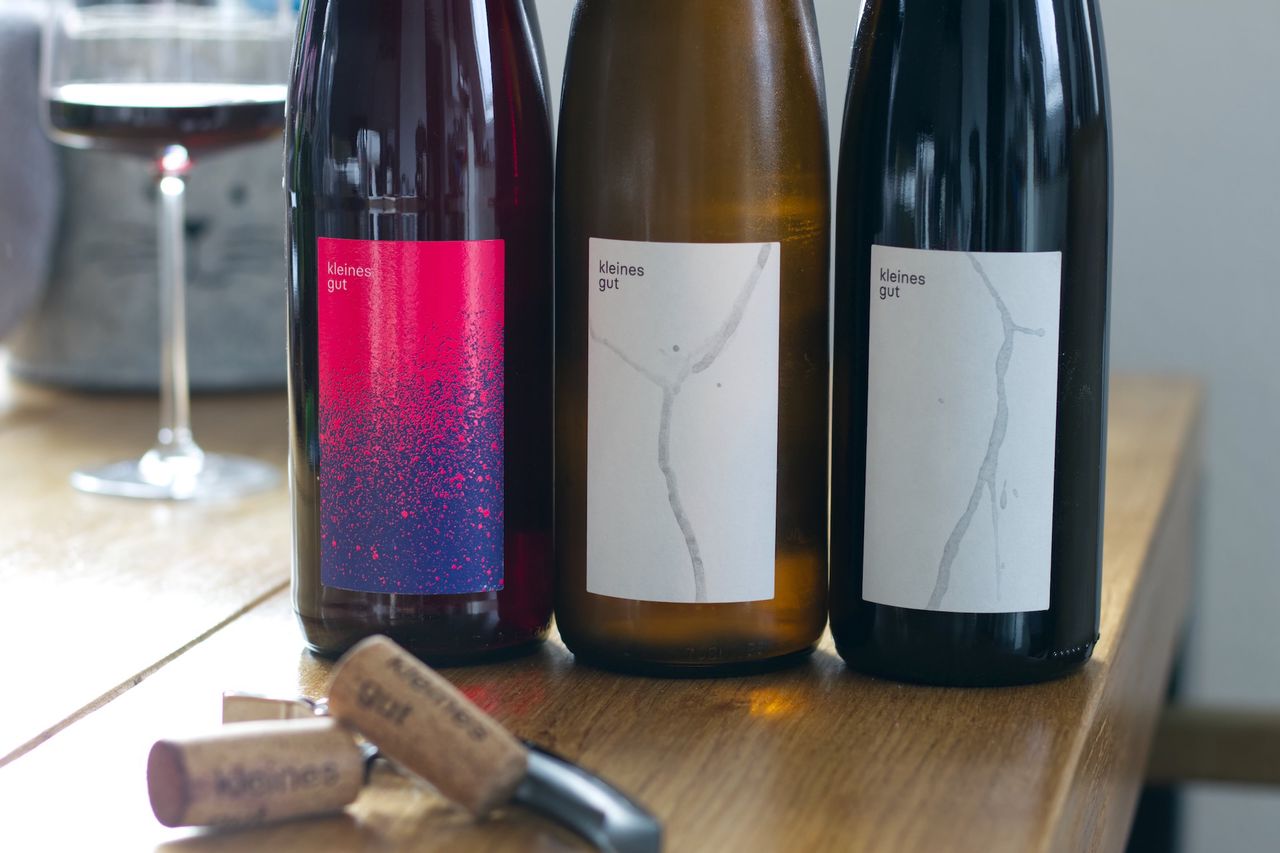Three Bottles Kleines Gut
We drink three bottles of Natural from Württemberg from the winery kleines gut for Easter: a Vin de Soif 2022, a bottle of Blanc 2021 and a bottle of Rouge 2021.

It really doesn’t happen that often that a new winery from Württemberg keeps popping up in my social media bubble. The last time that might have been the case with Lassak. And this time, it’s Daniel and Frederike from the kleines gut winery. The two have been cultivating about 3 hectares of vineyards in the south of Stuttgart around Uhlbach since 2020. The fact that one of the wines is called Vin de Soif, which is french for Saufwein, has certainly also helped that three bottles now end up in the blog as our Easter wine. The Vin de Soif, vintage 2022 and thus the first 2022 in my glass, comes with crown cork and is a cuvée of 60% Trollinger (yes, Trollinger again), 30% Pinot Noir and 10% Zweigelt, has 10% alcohol and is filled after 5 days maceration and aging in stainless steel tanks with minimal sulfur addition. Blanc 2021 combines all the white grape varieties grown in the winery. These are Weissburgunder, Silvaner, Kerner, Chardonnay and Riesling. The wine also has some maceration time, which varies by grape variety, is slowly pressed and then aged together in used 500 liter wooden barrels for one year. The Rouge, also 2021, is made from Lemberger, Merlot and Zweigelt, is macerated with the whole grapes and left for 10-12 days before also being slowly pressed and aged in used, smaller wooden barrels.
Let’s start with the Vin de Soif. We already knew roughly what to expect, having had a glass of this with some fabulous cheese toast at the equally fabulous Nova Bar in Stuttgart a few weeks ago. This smells pretty wild after uncorking and foams up a bit. It has something of a slightly fermented currant spritzer and apple cider. The bit of tannin is carried down the tongue by the bubbles and you begin to understand why the wine is called what it is. This is dry, juicy, fresh and uncomplicated. This is wine for the great thirst, which thankfully is also filled in magnums. Our bottle did not survive the evening, so if you want to know what might develop, rather buy magnum. Could be, though, that even that will run dry. This is charmingly dirty effervescent, blueberry and currant. Cool stuff.
The Blanc afterwards is then different, but also beautiful. This also smells distinctly of Natural, but is very clean and clear. There is apple peel, some nut and a bit of reduction mixed with yellow creaminess. Then on the tongue, powerful draw, lots of freshness and a fine tannin. This does a bit to the mouth what cider apples do when you’ve bitten into them a bit too deeply and a load of core has come along. In general, the acid structure, fruit and tannin make this feel totally like an apple. With more air, this then becomes a mix of baker’s yeast and green apple, it gets stouter in the mouth and sparser on the nose.
Overnight, the wine smells even more like nuts. But in the meantime it tastes slightly of exotic fruit. Super complex and above all nothing falls apart at all. That is the great art of omission in the Natural. That you still get it somehow clean into the bottle and it does not break before the first contact with oxygen on the tongue. There is real tension in the wine and a little caramel candy, which then disappears as quickly as it came. There is citrus, some lilac and generally just very much happening. You should like natural wines though, otherwise this is perhaps the wrong wine.
Rouge then hits me unexpectedly. Whereby I actually do not know exactly what I expected. Just not that I guess. This smells like really beautiful, dark berries. Blackberries, cassis and sloes and such. And at the same time, between the fruit, there’s the wildness that the other two bottles had as well. There’s a bit of glue, something musty, a bit of Haribo and a bit of bath water. When you have finished smelling and drinking, then you have so much sour cherry on the tongue, as I have rarely had. It’s really like eating sour cherries at first. Again with pits in it. Then with more air this goes more and more towards currant along with the green stems and gets wilder and wilder on the nose.
We then forgot to get the wine out of the fridge in time and so it enters the glass more near fridge than room temperature. But that suits it surprisingly well. It smells the same as the first night, but tastes like fruit juice with wood chip decoration on top. A bit like those dried limes on cocktails. You can see that, so maybe you taste a little more than is actually in it. Because tannin isn’t really there. If the first wine wasn’t already called Saufwein, I’d want to put that label on this one.
Have I ever said that you should definitely drink more Württemberg? No? Drink more Württemberg!